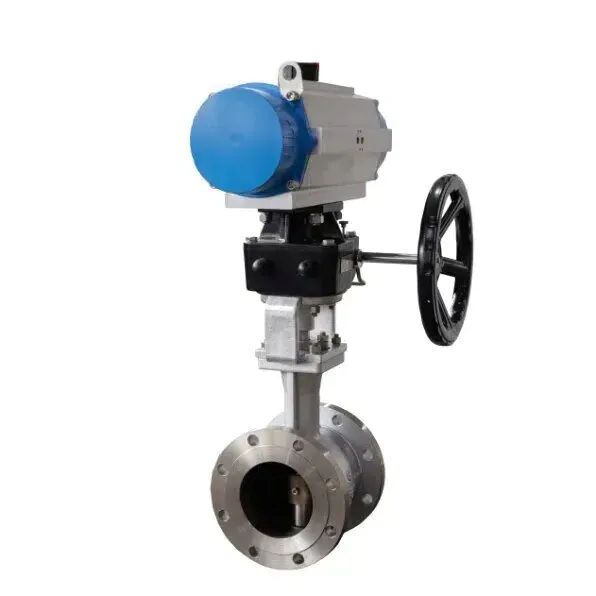We Are a Leading Control Valve Manufacturer in China, Delivering High-Quality Valves and Precision Control Actuators Customized for a Wide Range of Industrial Applications.
Eccentric plug valves are a sophisticated type of rotary control valve widely used in industries to regulate fluid flow. Unlike conventional plug valves, these valves feature an offset, or "eccentric," plug that rotates to control the passage of fluids. This unique design reduces friction and wear, resulting in improved sealing performance and a longer service life. Thanks to their robustness and versatility, eccentric plug valves excel in handling abrasive, viscous, and otherwise challenging fluids. They are indispensable in sectors such as mining, petroleum refining, power generation, and pulp and paper manufacturing.
This article explores how eccentric plug valves work, why flow direction is critical for their performance, and the importance of correct installation for ensuring optimal operation.
What Are Eccentric Plug Valves?
Eccentric plug valves fall under the category of rotary control valves designed to regulate fluid flow in various industrial processes. Unlike traditional plug valves, where the plug moves directly along the flow path, eccentric plug valves feature a plug that is offset from the centerline. This offset allows the plug to rotate with a cam-like motion, minimizing direct contact between the plug and the valve seat during operation.
Constructed from durable materials such as stainless steel or high-grade alloys, these valves withstand abrasive and viscous fluids, including slurries and heavy hydrocarbons. The rugged design, often incorporating metal trim parts, ensures reliability in harsh environments like slurry pipelines, coking units, and fluid systems subject to erosion or corrosion.
Eccentric plug valves can serve either throttling or on/off functions and are commonly equipped with flanged ends for easy installation in existing piping systems.
How Do Eccentric Plug Valves Work?
The key to the eccentric plug valve’s function lies in its off-center plug. When the valve opens, the plug rotates in a cam-like motion, lifting gradually away from the valve seat. This action minimizes friction and wear between the plug and seat, allowing smooth flow control and extending valve lifespan.
As the plug rotates further, the flow path opens progressively, enabling fluids to pass with minimal pressure drop. When closing, the plug rotates back to seal tightly against the seat, ensuring a secure, leak-proof closure without sudden pressure spikes.
Why Is Flow Direction Important?
The flow direction through an eccentric plug valve significantly affects its sealing ability, wear rate, and overall efficiency. Manufacturers typically mark the preferred flow direction on the valve body to guide proper installation.
Proper flow orientation is essential because:
- Sealing Integrity: Correct flow direction ensures the plug seats properly against the valve body, creating a reliable seal to prevent leakage.
- Reduced Wear: The eccentric design is optimized to minimize friction in the intended flow direction. Installing the valve incorrectly increases contact and wear, shortening its service life.
- Minimized Pressure Drop: Correct orientation allows fluid to flow smoothly through the valve, improving system efficiency and reducing energy costs.
Consequences of Incorrect Installation
Installing the valve against the recommended flow direction can cause:
- Accelerated Wear and Damage: Increased friction leads to faster deterioration of plug and seat surfaces.
- Leakage and System Failures: Poor sealing can result in fluid leaks, compromising system integrity.
- Higher Maintenance Costs: Premature wear necessitates more frequent repairs or replacements.
- Reduced Operational Efficiency: Increased pressure drop can cause higher energy consumption and lower throughput.
Industrial Applications of Eccentric Plug Valves
Eccentric plug valves are favored in industries requiring robust, precise flow control in tough environments:
- Slurry Handling: Widely used in mining, these valves handle abrasive mixtures of solids and liquids without clogging or excessive wear.
- Petroleum Refining: They regulate heavy hydrocarbons and crude oil flows reliably under harsh conditions.
- Power Generation: Control of steam, water, and other fluids under high pressure and temperature is a critical role for these valves.
- Pulp and Paper: Employed in chemical processing stages such as bleaching and pulping.
- Food and Beverage: Suitable for viscous fluids and hygienic processes where durable, precise control is needed.
Advantages of Eccentric Plug Valves
- Reduced Friction: The cam-like rotation decreases plug-seat contact, limiting wear.
- Precise Flow Control: Smooth plug movement enables fine-tuned throttling.
- High Durability: Robust construction withstands corrosive and erosive media.
- Lower Maintenance: Less wear means longer intervals between servicing.
- Versatility: Suitable for a wide range of fluids and operating conditions.
Conclusion
Eccentric plug valves offer a reliable, efficient solution for industrial flow control, combining precise regulation with enhanced durability. Proper attention to flow direction during installation is critical to achieving optimal performance and maximizing valve lifespan. By understanding the unique mechanics and flow considerations of eccentric plug valves, industries can reduce maintenance costs, improve efficiency, and ensure safe, trouble-free operation in demanding applications.Know more about Google SEO Directory





Comments